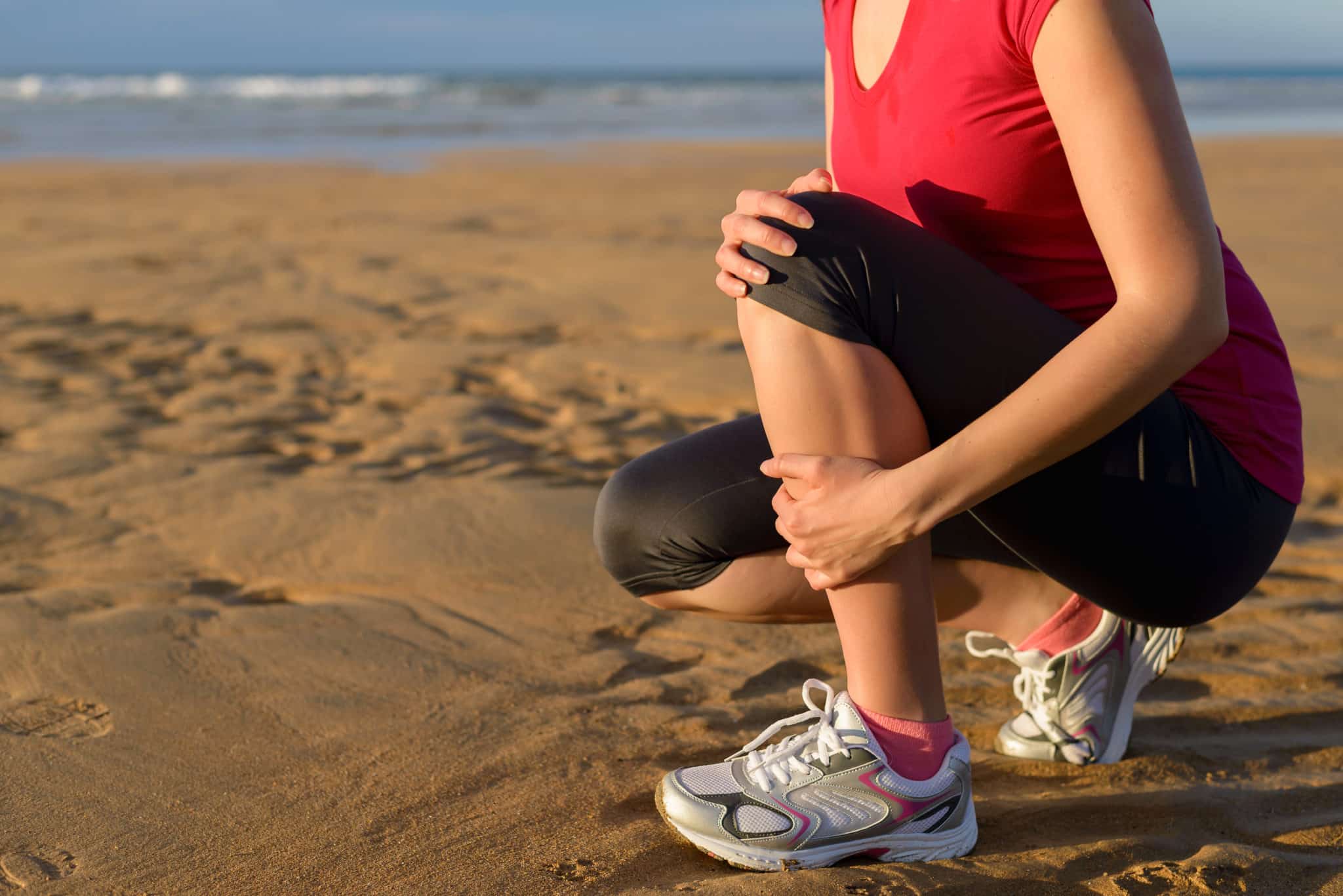Let’s face it: shin splints suck. One day you’re running two miles with ease and the next day, you’re struggling to run one block without needing to stop and rub your shins in pain. Ugh. What’s the deal? Before you swear off exercise all together and cozy up on the couch until the pain goes away, read on! We’ll tell you how to get rid of splints so you can get back to your workouts pain-free.
What Are Shin Splints?
Believe it or not, shin splints are one of the most common exercise injuries around! Also referred to as medial tibial stress syndrome (MTSS), shin splints cause a dull, throbbing, or radiating pain on the front or back of the lower leg (shin). The pain can be anything from uncomfortable to debilitating. Runners and frequent walkers commonly get shin splints, but they can also happen to people who do a lot of high-impact workouts or increase their training by too much too soon.
Symptoms of Shin Splints
The main symptom of shin splints is that telltale pain near your shinbone. But other symptoms and sensations can also occur when you have shin splints. Here are a few other symptoms you might experience:
- shin pain
- mild swelling
- pain brought on or specifically made worse by exercise
- feet numbness or weakness
What Causes Shin Splints?
Shin splints are extremely common and have many causes. Many people develop shin splints after overtraining. They may be new to exercise or decide to be overly ambitious with their training and go too hard, too fast. Runners who dramatically increase their mileage, for example, are prone to developing shin splints—but it’s not just runners who suffer from this common condition. Common causes of shin splints include:
- Sudden increase in intensity or duration of exercise
- Exercising on hard surfaces that offer poor shock absorption
- Over pronation (rolling your feet inward as you walk or run)
- Over supination (rolling your feet outward as you walk or run)
- Excessive stress on your legs
- Wearing improper, worn-out workout shoes
- Lack of flexibility or stretching
- Flat feet
- Muscular imbalance (overly tight calves)
Whatever caused your shin splints, it’s best to take a break from activities that place excessive strain on your legs, such as jogging. Let’s examine some ways you can treat shin splints at home.
Related: 7 Workout Mistakes That Can Leave You In Pain
7 Ways To Treat Shin Splints
Your doctor is the only one who can definitively diagnose shin splints, but if you suspect that’s the cause of your shin pain, there are some short-term solutions that can help. Here are seven things you can do to treat shin splints at home:
1. Take A Break
It’s common to want to “go big or go home” when training for a race or beginning an exercise regimen, but doing too much too fast is what often causes shin splints. This is particularly true with runners who increase their mileage by leaps and bounds. Let your body rest for a few days to see how it feels; the sooner you deal with the pain by actually recovering, the sooner you can get back to your workouts.
2. Ice!
As a general rule of thumb, you want to ice newer injuries and use heat on chronic, long-lasting pain. If your shin splints are new, try icing them. Apply an ice pack every 30 minutes or so for a few hours to lessen the swelling and reduce pain, and do this for a few days to see if it helps.
3. Switch Surfaces

Pounding the pavement on a long run can feel so great at the time, but the truth is that running on hard surfaces (like pavement) is high-impact and can be hard on your legs. Move your walking/running routine to a softer surface for a few weeks. Consider exercising on a treadmill, grass, gravel, or sand. If you are lucky enough to live near a beach, take advantage of it! A change in turf will reduce the shock that travels through the legs.
4. Check Your Gait
Oftentimes, we’re not even aware of how we move our feet when we walk because it’s second nature to us! But if you rotate your foot too far in any direction when running or walking, you can definitely develop shin splints. A local running store can often help you with a gait analysis; simply by watching you walk across the room, they can usually tell if you over pronate or over supinate when you walk. (A chiropractor can help you with this information as well). If you over pronate or over supinate, purchasing orthotic shoe inserts can also be beneficial.
5. Pace Yourself
Increase your outdoor mileage gradually. Walking or sprinting an instant 5K after a winter-long hibernation will leave your muscles overworked. Slowly work your way up in mileage so that your body isn’t struggling to keep up; practicing moderation will keep shin splints at bay.
6. Cross-Train
Doing the same thing over and over not only gets boring, but it can put a lot of stress on your feet! Cross-training offers variety and muscle relief, not to mention a change of pace. If you’re a regular runner, try swimming for a few workouts. If you’re into high impact HIIT workouts, switch it up with pilates or spin class—both of which are a little easier on your joints. By alternating your exercise regime, the various muscle groups receive less overall stress.
Related: Agility Ladder Drills that Burn Serious Calories
7. Stretch
Simple stretching is one of the most underrated forms of therapy and relief for your body. If you’re someone who exercises frequently, you need to be stretching in order to avoid pain of all sorts. Try yoga or some gentle stretching after every workout; make it part of your daily routine and your shins will thank you!
Long-Term Shin Splint Exercises
We’ve discussed some short-term treatments for shin splints, but you also can do specific exercises to strengthen your legs and avoid them in the future. (Prevention is the best treatment, right?!)

The mechanics of how shin splints occur have to do with weakness in the tibias anterior, the lower leg muscle where the pain tends to throb. Everything in the body is connected, so you need to start (quite literally) from the ground up if you want to strengthen the lower leg and reduce your pain. The following exercises incorporate your feet, ankles, heels and calves to help strengthen your shins. Try the exercises daily to help keep shin splints away for good.
- Flex and point the toes anytime you’re sitting. Make this a daily routine.
- While standing or siting, lift your foot slightly off of the ground and draw the alphabet with your toes. Repeat on the other side.
- Walk on your heels. Walk across the room two or three times at first and slowly build up to repetitions.
- Do calve stretches: sit o the floor with your legs out in front of you. Loop a towel or resistance band around your feet and gently pull back, holding for 15 seconds and repeating twice on each leg.
It’s great to be enthusiastic about a new workout routine, or to want to run more miles than you ever have before. But by respecting your muscles first and foremost, you can avoid shin splints and meet your goals faster. And if you’re currently dealing with shin splints, listen to your body, let it recover, and work to prevent them in the future. Nothing kills a workout faster than pain, and it’s one thing you don’t need standing in the way of you and your daily exercise!

4 Comments
toni on December 29, 2020 at 12:56 PM
It’s important to stretch out tight calf muscles, your gastronomies, and the soleus. These large muscles at the back of your leg run from your knee to your heel. Stretch each calf muscle separately.
Suzanne on July 28, 2015 at 3:39 PM
I believe shin splints occur from landing on your heel (toes up) and over time the, muscle and/or tendon, will shorten and that is where the pain comes. I cured my, shin splints, by kneeling down and sitting on my heels (toes pointing out behind) which will stretch the, tendons and muscles, of the shins. Over time you will want to lean backwards to get more stretch into the, tendons and muscles. I hope you will get the same relief I did out of this method.
Vanessa on July 27, 2015 at 10:43 AM
i find that i get shin splints when i fail to raise my knees high enough with each stride, and to compensate i'm pulling up my toes so as not to trip. i had no idea i was doing this at first, but if you get shin splints try lifting your knees a little higher as you run and see if it works for you.
Suzanne on July 28, 2015 at 3:49 PM
I had shin splints so bad I cried myself to sleep while rubbing the hell out of them. What I did to "cure" my shin splints. You will kneel down and sit on your heels toes pointing out behind you. This will stretch the tendons and muscles up your shins. Over time as they stretch out you'll want to lean backwards to get a longer stretch. I hope you get the same effect as I did. At first it will hurt, but, the more you do it the easier it gets.